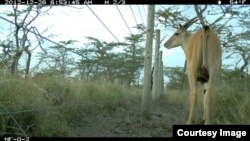Earth is in the midst of its sixth mass extinction of animal species -- the first to be caused by humans -- in the past half-billion years, setting off a downward spiral in the environment and human health, which will accelerate unless action is taken, according to a new report in Science.
Co-author Hillary Young studies what happens when the big animals disappear. In her field work in Central Kenya, the University of California Santa Barbara researcher documents changes in four-hectare parcels of land, fenced to keep out giraffes and zebras and elephants.
“We can measure things like the abundance of vegetation, the abundance of rodents, and the prevalence of disease in the wildlife species that are left behind,” she said.
Rapid decline
Rather quickly the fenced parcels fill with grasses and shrubs, providing cover for rats which overwhelm the area and are vectors for human disease.
Young and her colleagues have coined a new term for this pattern of animal species loss. They call it defaunation.
“We have lost more than 25 percent of all the vertebrates in the world - this is the number of individual animals in the world - and probably more than 45 percent of the invertebrate animals in the world," she observed. "On an average year, we’re probably losing 11,000 to 58,000 animal species. That’s just shocking to think about.”
Beetles, bugs and butterflys disappearing too
This loss is all the more surprising, Young says, because similar patterns are playing out across species worldwide.
“We tend to think of extinction and species decline in the terms of giant pandas or polar bears, but what we find is that these small invertebrates - the beetles, the worms, the moths and the ladybugs - those animals are declining at rates that were equivalent if not greater than the large species,” she said.
These are signs, Young says, that the sixth mass extinction is under way. The study affirms that humans are speeding it up by destroying wild lands and over-exploiting animals and resources. This, in turn, has triggered invasions of exotic species and climate change on a grand scale.
Animals protect vital human services
Young says conservation is not an esoteric luxury to keep wildlife around.
“Basic ecosystem functions like soil protection or water purification or carbon cycling to keep the soils rich and the atmosphere clean - all of those are services provided by animals, often these invertebrates that we don’t think about so much, but also the larger vertebrates," she said. "And what we find is that when we lose these animals, we see massive changes in these ecosystems, functions in the systems that are impacted.”
As species die off, Young warns that defaunation can permanently upset the trajectory of life on Earth. She says that loss, if left unchecked, will become a driver of global change rather than a consequence of it.
“It is going to exacerbate climate change [and] water stress. It is going to increase human poverty and social conflict. These are themselves going to lead to more wildlife declines, and it’s going to create a downward spiral and we’re going to lose the opportunity to halt this spiral,” she said.
Young says slowing this planetary nightmare will require political will. She says immediately addressing habitat loss and over-exploitation of animals and resources would help in the short term, but in the long run, global action to curb climate change is imperative.









